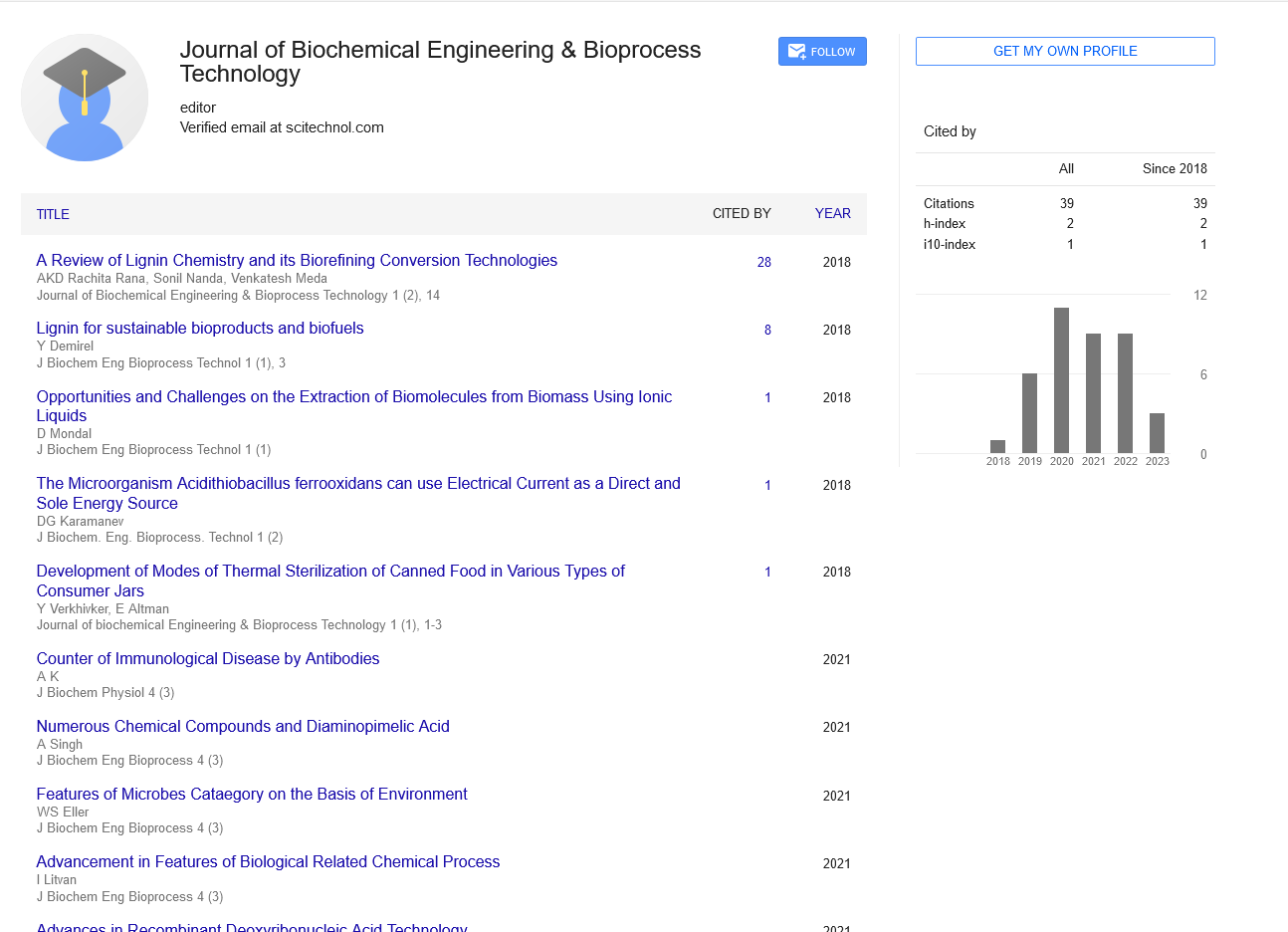Perspective, J Biochem Eng Bioprocess Vol: 4 Issue: 4
Wastewater created by Ventures as a Bothersome Result
Ram Chandra*
Department of Biotechnology, California Institute of Technology, US
*Corresponding author: Chandra R*, California Institute of Technology, U.S, Email: ramchandra@gmail.com
Received date: July 1, 2021; Accepted date: July 16, 2021; Published date: July 22, 2021
Abstract
Modern wastewater treatment depicts the cycles utilized for treating wastewater that is created by ventures as a bothersome result. After treatment, the treated mechanical wastewater (or profluent) might be reused or delivered to a sterile sewer or to surface water in the climate. Most modern cycles, like petrol treatment facilities, compound and petrochemical plants have nearby offices to treat their wastewaters so the poison focuses in the treated wastewater follow the guidelines with respect to removal of wastewaters into sewers or into streams, lakes or seas. Mechanical wastewater treatment plants are required where city sewage treatment plants are inaccessible, don't have adequate limit or can't satisfactorily treat explicit modern wastewaters. Most enterprises produce some wastewater.
Keywords: atomic industry
Introduction
Modern wastewater treatment depicts the cycles utilized for treating wastewater that is created by ventures as a bothersome result. After treatment, the treated mechanical wastewater (or profluent) might be reused or delivered to a sterile sewer or to surface water in the climate. Most modern cycles, like petrol treatment facilities, compound and petrochemical plants have nearby offices to treat their wastewaters so the poison focuses in the treated wastewater follow the guidelines with respect to removal of wastewaters into sewers or into streams, lakes or seas. Mechanical wastewater treatment plants are required where city sewage treatment plants are inaccessible, don't have adequate limit or can't satisfactorily treat explicit modern wastewaters. Most enterprises produce some wastewater. Late patterns have been to limit such creation or to reuse treated wastewater inside the creation cycle. Wellsprings of modern wastewater incorporate battery producing, electric force plants, food industry, iron and steel industry, mines and quarries, atomic industry, oil and gas extraction, natural synthetic substances fabricating, oil refining and petrochemicals, mash and paper industry, smelters, material factories, mechanical oil pollution, water treatment, wood protecting. Treatment measures incorporate salt water treatment, solids evacuation (for example synthetic precipitation, filtration), oils and oil expulsion, evacuation of biodegradable organics, evacuation of different organics, expulsion of acids and soluble bases, expulsion of harmful materials. Petroleum product power stations, especially coal-terminated plants, are a significant wellspring of mechanical wastewater. A considerable lot of these plants release wastewater with huge degrees of metals like lead, mercury, cadmium and chromium, just as arsenic, selenium and nitrogen compounds (nitrates and nitrites). Wastewater streams incorporate vent gas desulfurization, fly debris, base debris and pipe gas mercury control. Plants with air contamination controls, for example, wet scrubbers ordinarily move the caught toxins to the wastewater stream. Debris lakes, a sort of surface impoundment, are a broadly utilized treatment innovation at coal-terminated plants. These lakes use gravity to settle out enormous particulates (estimated as complete suspended solids) from power plant wastewater. This innovation doesn't treat broke up toxins. Force stations utilize extra innovations to control poisons, contingent upon the specific waste stream in the plant. These incorporate dry debris taking care of, shut circle debris reusing, compound precipitation, organic treatment, (for example, an actuated muck measure), film frameworks, and dissipation crystallization frameworks. Innovative headways in particle trade films and electro dialysis frameworks has empowered high effectiveness treatment of pipe gas desulfurization wastewater to meet ongoing EPA release limits. The treatment approach is comparative for other profoundly scaling modern wastewaters. Wastewater created from horticultural and food preparing tasks has particular qualities that put it aside from normal civil wastewater oversaw by open or private sewage treatment plants all through the world: it is biodegradable and non-poisonous, yet has high Biological Oxygen Demand (BOD) and Suspended Solids (SS). The constituents of food and farming wastewater are regularly intricate to anticipate, because of the distinctions in BOD and pH in effluents from vegetable, organic product, and meat items and because of the occasional idea of food preparing and post-collecting.
The chief waste-waters related with mines and quarries are slurries of rock particles in water. These emerge from precipitation washing uncovered surfaces and take streets and furthermore from rock washing and evaluating measures. Volumes of water can be high, particularly precipitation related arisings on enormous sites. Some specific detachment tasks, for example, coal washing to isolate coal from local stone utilizing thickness angles, can create wastewater tainted by fine particulate haematite and surfactants. Oils and pressure driven oils are additionally normal foreign substances. Wastewater from metal mines and metal recuperation plants are unavoidably defiled by the minerals present in the local stone developments. Following pulverizing and extraction of the positive materials, bothersome materials may enter the wastewater stream. For metal mines, this can incorporate undesirable metals, for example, zinc and different materials like arsenic. Extraction of high worth metals, for example, gold and silver may create oozes containing extremely fine particles in where actual expulsion of impurities turns out to be especially troublesome. Also, the geologic developments that harbor monetarily important metals, for example, copper and gold frequently comprise of sulfide-type minerals. The handling involves granulating the stone into fine particles and afterward separating the ideal metal(s), with the extra stone being known as tailings. These tailings contain a mix of bothersome extra metals, yet in addition sulfide segments which ultimately structure sulphuric corrosive upon the openness to air and water that unavoidably happens when the tailings are discarded in huge impoundments. The subsequent corrosive mine seepage, which is frequently wealthy in hefty metals (since acids break down metals), is one of the numerous natural effects of mining.
 Spanish
Spanish  Chinese
Chinese  Russian
Russian  German
German  French
French  Japanese
Japanese  Portuguese
Portuguese  Hindi
Hindi 